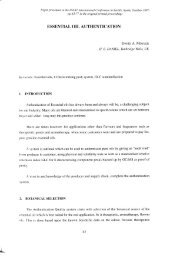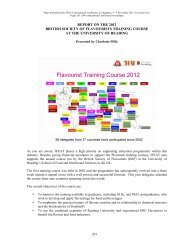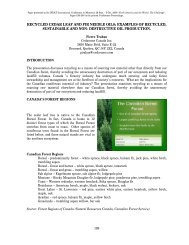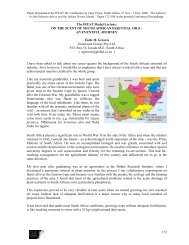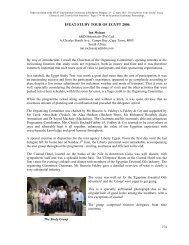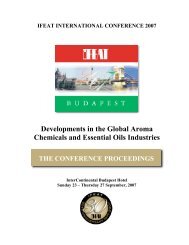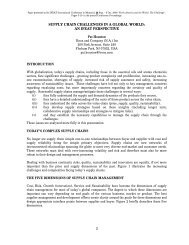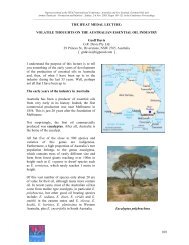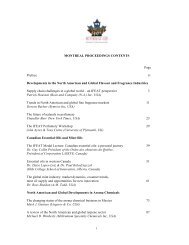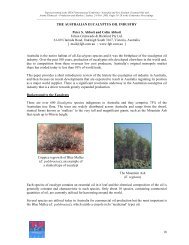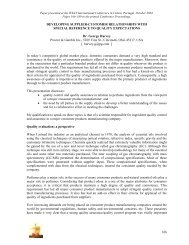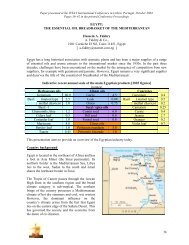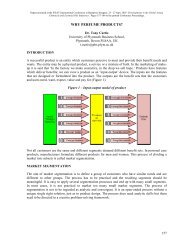PARAGUAY: AN OVERVIEW OF THE ESSENTIAL OILS ... - IFEAT
PARAGUAY: AN OVERVIEW OF THE ESSENTIAL OILS ... - IFEAT
PARAGUAY: AN OVERVIEW OF THE ESSENTIAL OILS ... - IFEAT
You also want an ePaper? Increase the reach of your titles
YUMPU automatically turns print PDFs into web optimized ePapers that Google loves.
Paper presented at the <strong>IFEAT</strong> 2001 International Conference – ‘The Essential Oils of South and Central America’;<br />
Buenos Aires, Argentina; 11-15 Nov. 2001. Pages100 –107 in the Conference Proceedings.<br />
_________________________________________________________________________________________<br />
<strong>PARAGUAY</strong>:<br />
<strong>AN</strong> <strong>OVERVIEW</strong> <strong>OF</strong> <strong>THE</strong> <strong>ESSENTIAL</strong> <strong>OILS</strong> INDUSTRY<br />
Raul Amigo<br />
Amigo & Arditi S.A.<br />
Ruta Mariscal Estigarribia Nº 1282, Fernando de la Mora, Asunción, Paraguay<br />
[ raul@amigo.com.py ]<br />
Paraguay is a land-locked country, located in the heart of South America and shares borders with<br />
Brazil, Argentina and Bolivia. It occupies an area of 406,752 km 2 and has a semi-tropical climate. The<br />
eastern region is an extension of the Brazilian Plateau, much of which remained virgin forest up until<br />
the latter part of the twentieth century. The larger western region is a part of the Gran Chaco and is<br />
hotter and semi-arid.<br />
The capital city, Asunción, sits on the River Paraguay and is the traditional port for exports. The total<br />
population of Paraguay is estimated as around 5.5 million, of which the some 45% live in the<br />
countryside.<br />
Paraguay and its neighbours<br />
The production and export of essential oils commenced in the late 19 th century. The industry remains a<br />
significant source of cash earnings in many rural areas and of foreign exchange earnings for the<br />
country.<br />
100
On the international market, Paraguay is best known today as a supplier of the oils of petitgrain,<br />
guaiacwood and cabreuva. During the 1970s, Mentha arvensis oil production developed and was soon<br />
followed by further processing to menthol crystals and dementholized oil, but this industry has<br />
contracted since the mid-1980s. Table 1 summarises recent production levels for these oils and Table 2<br />
lists their particular production characteristics.<br />
Table 1 : The recent scale of production of the four main Paraguayan oils<br />
(tonnes/year)<br />
Late 1990s<br />
Cabreuva 20<br />
Guaicwood 100 - 150 Prior peak output<br />
Petigrain 250-350 400 - 450 (in 1960s/70s)<br />
Crude M. arvensis 100 1,200 (in 1975/80)<br />
Table 2 : Production systems and areas for the four oils<br />
Source of raw material Oils Location of<br />
production<br />
Cultivation,<br />
Petitgrain<br />
traditionally as first<br />
cash crop on newly<br />
East and north east of<br />
Asuncion towards<br />
Brazilian border<br />
colonized land Mentha arvensis Along the border with<br />
Parana State, Brazil<br />
Harvesting wild trees<br />
Cabreuva<br />
Guaiacwood<br />
The southern region,<br />
bordering Argentina<br />
The Chaco; western<br />
region bordering on<br />
Bolivia<br />
Producers<br />
Paraguayan<br />
smallholders<br />
Predominantly<br />
Brazilian immigrant<br />
farmers in peak<br />
production period.<br />
The Mennonite<br />
community in the<br />
Chaco<br />
Petitgrain Oil.<br />
Paraguay petitgrain oil is produced by steam distillation of the leaf (with stems attached) of the bitter<br />
orange tree (Citrus aurantium subsp. amara Linn). This is one of the several orange species<br />
introduced during the 17 th and 18 th centuries by Spanish colonists and it rapidly established itself as a<br />
wild plant in many areas.<br />
Commercial production of the oil commenced around 1880 in the area to the east of Asuncion. Soon,<br />
petitgrain cultivation became a key component in smallholder systems with the role of the first cash<br />
crop planted on colonising and clearing virgin forest. Today, cultivation and distillation remains<br />
dependent on subsistence smallholders, but the major production areas have progressively relocated to<br />
the northeast, along with the borders of new land colonisation. It is estimated that today about 20,000<br />
families are involved directly and indirectly on petitgrain oil production<br />
Petitgrain’s significance to subsistence farmers lies in its ability to be harvested and distilled<br />
throughout most of the year and to provide a cash return immediately by sale to the well-established<br />
101
ural network of village intermediaries (often the general stores) or directly to the local agents of<br />
exporters.<br />
Cultivation and distillation<br />
The petitgrain is grown in rows and by regular coppicing the plants are kept as low bushes to<br />
maximise leaf production.<br />
Distillation of the harvested leaf is carried out in traditional wooden-barrel still pots, served with steam<br />
generated in a simple satellite boiler and a variety of types of rustic condensers are used.<br />
In the mid-twentieth century, some of exporter companies experimented on improving distillation with<br />
modern metal equipment, but the quality of the oil obtained proved unacceptable to users.<br />
During the early 1970s, a systematic examination of means of improving the petitgrain industry in<br />
Paraguay was carried out by the Tropical Products Institute (later known as the Natural Resources<br />
Institute) under a British aid project. Field trials with the TPI’s modern transportable still achieved an<br />
oil yield improvement of up to 25% over the traditional stills but the product was again different (and<br />
unacceptable) in aroma quality to the traditional oil. Analyses revealed that distillation with a modern<br />
efficient still provided an oil very similar in composition to that occurring naturally in the leaf whereas<br />
the inefficient traditional stills transformed the oil – and its aroma character - by partial hydrolysis of<br />
the linalyl acetate component. Perfumers had come to accept the traditional oil, containing distillation<br />
artefacts, as the norm. The project was forced to re-focus attention on simple means of improving the<br />
general efficiency of traditional equipment, while maintaining the product characteristics (1) . Those<br />
interested in the details of this work may refer to the paper presented at <strong>IFEAT</strong>’s first international<br />
conference in Bangalore, India in 1979 (2) .<br />
Production and exports<br />
The 1960s to the mid-1970s saw exports of Paraguay petitgrain oil increase to their peak level of 400 -<br />
450 tonnes annually. However, fluctuations in supply and price then occurred for some years for<br />
several reasons, including a switch to more remunerative tobacco and cotton in the petitgrain growing<br />
areas immediately to the east of Asuncion. By the 1980s, this brought about a progressive reduction in<br />
demand from some Paraguay petitgrain oil users, who turned to alternative fragrance ingredients.<br />
Production and demand eventually stabilised at a lower level than formerly. Exports during the second<br />
half of the 1990s ranged between 250 – 300 tonnes annually (see Chart 1). No reliable statistics are<br />
kept on production but the actual levels are believed to correspond reasonably closely with the exports<br />
over the same period.<br />
The reduction shown in exports over the last few years is a result of adverse weather on the crop and,<br />
since supply failed to match demand, prices were higher than normal. Growers have responded<br />
recently to the increased oil price by expanding their cultivation area and this will lead in the coming<br />
years to a return to normal supply and export prices.<br />
Between 1995 and 2000, Europe purchased almost 80% of all exports of Paraguay petitgrain.<br />
102
Chart 1:<br />
PETITGRAIN OIL<br />
Exports in tons<br />
263<br />
290<br />
252<br />
225<br />
242 238<br />
1995 1996 1997 1998 1999 2000<br />
Chart 2:<br />
PETITGRAIN OIL - Exports by zones<br />
79.53%<br />
13.22%<br />
5.96%<br />
1.29%<br />
Europe USA South America Asia<br />
Mentha Arvensis and Menthol<br />
Cultivation<br />
Like petitgrain, the development of crude Mentha arvensis oil in Paraguay was intertwined with its<br />
utility as the first cash crop on the colonization of virgin forest land. However, it differed in that<br />
production was initiated, not by Paraguayans, but by Brazilian immigrant communities who received<br />
financial support from entrepreneurs based in Brazil.<br />
103
Introduction of the crop into Paraguay was the logical outcome of the pattern of production that had<br />
emerged in Brazil since the 1940s, combined with the Paraguayan government’s favourable attitude to<br />
immigration as means of opening up the under-populated and under-developed southeastern border<br />
area with Brazil.<br />
Mint in Brazil had been used as the first cash crop on opening up new forest land in Parana state.<br />
Cultivation, usually without fertilization, continued on a site for between 3-8 years until yields fell. At<br />
this stage, the land was ploughed and put under mechanised production of soya and maize. This<br />
practise led to a constant move westwards (and of the mint production areas) from Sao Paulo towards<br />
the border with Paraguay. Shortages of suitable land in Brazil, combined with increasing land prices<br />
turned the attention of Brazilian processors and colonists to Paraguay in the 1960s, where land was<br />
cheaper and the topography was more favourable for eventual transformation to mechanised<br />
agriculture.<br />
Production of crude Mentha arvensis oil in Paraguay rose to its peak during 1975 – 1980, around<br />
1,200 tonnes annually. Approximately 90% of this output arose from the Brazilian immigrant<br />
community, while Paraguayan farmers accounted for the remainder.<br />
Most of the early crude oil production was sold to the Brazilian menthol processing industry. The<br />
development of local processing to menthol and dementholized oil did not occur until the mid-1970s.<br />
The promise of a progressive growth in the Paraguayan industry was dashed with China’s aggressive<br />
entry onto the world market in the late 1970s. Lower world market prices reduced production<br />
profitability in Paraguay and during the 1980s crude oil output fell to under 100 tonnes annually.<br />
There has been steady growth in production of crude Mentha arvensis oil in Paraguay over the past<br />
five years and the current annual output is about 90 - 100 tonnes.<br />
Chart 3:<br />
CRUDE MENTHA ARVENSIS OIL<br />
Production in tons<br />
90<br />
45 45<br />
55<br />
65<br />
70<br />
1995 1996 1997 1998 1999 2000<br />
104
Because of the comparatively high price of Paraguayan menthol crystals and dementholized<br />
peppermint oil, these products are used today by only a limited number of consumers, mainly in USA<br />
and Europe.<br />
Provided that international market prices do not undergo a significant decrease, it is expected that<br />
production of crude oil, menthol and dementholized oil in Paraguay will remain close to their current<br />
levels.<br />
Guaiacwood.<br />
The guaiacwood tree (Bulnesia sarmientoi) is a Paraguayan native species, which occurs in the semiarid,<br />
western Chaco region. The production of guaiacwood oil was initiated in 1950 by the Mennonite<br />
community; an immigrant religious sect that had colonized the central Paraguayan Chaco since 1927.<br />
In the early years, oil was produced by water-steam distillation of chipped wood. Over the following<br />
years, the technology has transformed to steam distillation of sawdust, chips and wood shavings.<br />
Today, production of guaiacwood oil is limited to only four producers and, in recent years, one of<br />
them has accounted for between 63% and 80% of the total exports.<br />
Although producers are confident of the continued availability of guaiac trees for many more decades,<br />
the Paraguayan government has introduced conservation regulations that control the permissible level<br />
of harvesting.<br />
Exports during the second half of the 1990s ranged between 100 – 180 tonnes annually. No shortage<br />
problems are expected in the foreseeable future. However, it is not possible to predict whether the<br />
trend to lower usage will continue in the major markets of the USA and Western Europe.<br />
155<br />
Chart 4:<br />
GUAIACWOOD OIL<br />
Exports in tons<br />
183<br />
98<br />
125 123<br />
113<br />
1995 1996 1997 1998 1999 2000<br />
105
Chart 5:<br />
GUAIACWOOD OIL - Exports by zones<br />
46.43%<br />
41.69%<br />
6.73%<br />
5.15%<br />
USA Europe South America Asia<br />
Cabreuva<br />
This oil is produced by steam distillation of the sawdust, chips and wood shavings of the indigenous<br />
Myrocarpus tree. Its main component is nerolidol, 75% to 85% of the total.<br />
Cabreuva oil production began in in the southwest region of Paraguay around 1980, and there are only<br />
two producers today.<br />
Recent annual output is around 20 tons a year and consumption is restricted to a small number of<br />
companies, predominantly in Western Europe.<br />
As in the case of guaiacwood the permissible scale of harvesting wild trees is controlled by<br />
Government conservation regulations.<br />
Chart 6:<br />
CABREUVA OIL<br />
Exports in tons<br />
17<br />
18<br />
22<br />
23<br />
12<br />
26<br />
1995 1996 1997 1998 1999 2000<br />
106
Chart 7:<br />
CABREUVA OIL - Exports by zones<br />
84.64%<br />
9.15%<br />
6.21%<br />
Europe USA South America<br />
Production of Other Oils.<br />
Since 1978, there has been production of citronella, lemongrass, palmarosa and three eucalyptus oils<br />
on a plantation venture in the northeast of Paraguay, close to the border with Brazil (see Table 3<br />
overleaf for volumes).<br />
These oils are mainly sold on the local market and to Brazil.<br />
Expansion of the scale of production has been constrained by problems of competitiveness on the<br />
international market, mainly on the basis of price but the aroma character of a few products differs<br />
somewhat from those of other origins<br />
Table 3: Recent production scale of other oils<br />
(tonnes/year)<br />
Citronella 10<br />
Lemongrass 2<br />
Palmarosa 5<br />
Eucalyptus globulus 10<br />
Eucalyptus citriodora 25<br />
Eucalyptus staigeriana 1<br />
Raul Amigo has been involved since 1982 in the family-owned, essential oils firm of Amigo & Arditi<br />
S.A. and has been the Export Manager since 1995. He is the current President of the Paraguayan<br />
Petitgrain Exporters Chamber.<br />
107
References cited<br />
1. Alvarez, A.A., Molinas, J., Montiel, J.A., Aguilera, X., Vargas, J.M., Urbieta, J.C., Seqouia, M.T.,<br />
Green, C.L., Baker, D., and Barrett, R. (1979). La Essencia de Petitgrain. (Como obtener mas<br />
Produccion de Mejor calidad). Asuncion, Paraguay: Paraguay Ministry of Agriculture Extension<br />
Department Booklet # 9.<br />
2. Baker, D. (1979) Paraguay Petitgrain Oil. Paper presented at the <strong>IFEAT</strong> International Conference<br />
in Bangalore, India, 1979.<br />
108



